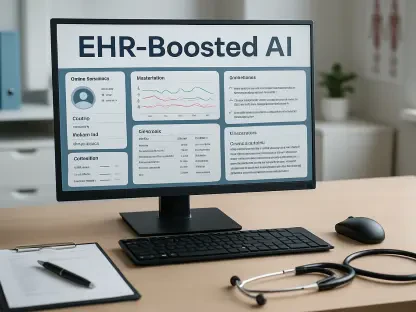In the midst of a grueling government shutdown in 2025, hospitals across the nation are caught in a financial vise, forced to slash budgets for critical technology that powers patient care, leaving many in dire straits. Picture a rural hospital, already stretched thin, unable to upgrade its outdated electronic health record system because federal funding streams have dried up. This scenario is not a distant fear but a stark reality for many healthcare providers grappling with the fallout of political gridlock. The ripple effects touch everything from patient data security to operational efficiency, raising urgent questions about how the healthcare IT sector can weather this storm.
The significance of this crisis cannot be overstated. With key federal programs like Medicare Dependent Hospital payments and Medicaid Disproportionate Share Hospital funding in limbo, healthcare facilities—particularly those serving vulnerable populations—are facing unprecedented cash flow challenges. This financial strain directly impacts IT spending, a cornerstone of modern healthcare that ensures everything from telemedicine access to cybersecurity protections. Understanding the depth of this issue reveals not just a temporary setback but a potential long-term threat to innovation in an industry vital to millions.
A Fiscal Freeze: The Chill of Shutdown on Healthcare IT
The government shutdown has unleashed a fiscal freeze that sends shivers through the healthcare IT landscape. Hospitals, reliant on federal reimbursements and grants, find themselves in a precarious position as funding uncertainties mount. Without consistent cash inflows, many facilities are forced to reevaluate every expenditure, with technology budgets often taking the first hit. This immediate reaction stems from the need to preserve resources for essential operations like staffing and patient care supplies.
Beyond the surface-level cuts, the shutdown disrupts the momentum of digital transformation in healthcare. Initiatives that were once prioritized, such as adopting cloud-based systems or enhancing interoperability, are now sidelined as administrators grapple with day-to-day survival. The broader implication is a stalling of progress in an era where technology is integral to improving patient outcomes and streamlining operations, leaving the sector vulnerable to inefficiencies.
This financial chill also casts a shadow over smaller and rural hospitals, which lack the financial buffers of larger systems. These facilities, often serving as lifelines for underserved communities, face the toughest choices, sometimes deferring critical IT upgrades that could mean the difference between secure data management and a devastating breach. The stakes of this fiscal freeze are high, setting the stage for a deeper examination of policy impacts on healthcare technology.
The Stakes of Shutdown: Linking Policy to IT Challenges
Delving into the mechanics of a shutdown reveals a direct connection between federal policy and the operational hurdles in healthcare IT. When government funding stalls, programs that support hospitals—especially those in economically challenged areas—grind to a halt. This interruption creates a domino effect, where reduced reimbursements translate into tighter budgets, forcing administrators to rethink every dollar spent on technology.
The impact is particularly acute for systems like data analytics and patient management tools, which require consistent investment to maintain functionality and compliance with regulations. Without federal support, many hospitals struggle to justify these costs, risking penalties for non-compliance or, worse, compromising patient safety through outdated systems. This policy-driven uncertainty underscores a critical vulnerability in the healthcare ecosystem, where political decisions reverberate through hospital corridors.
Moreover, the shutdown exacerbates existing disparities in healthcare access. Facilities dependent on government-insured patients, such as those in rural regions, face heightened risks of service disruptions if IT systems cannot be maintained or upgraded. This dynamic illustrates how a distant political stalemate can have immediate, tangible consequences for the quality of care delivered to communities nationwide.
Shifting Priorities: Hospitals Redefine IT Investments
Faced with the shutdown’s financial squeeze, hospitals are pivoting to a survival mindset, reshaping their IT spending in profound ways. Data from a recent Black Book Research survey of 107 healthcare IT vendor leaders highlights this shift: 71% of vendors report paused procurements, while 68% note delays in new requests for proposals. This trend reflects a laser focus on immediate needs over ambitious, long-term projects.
A closer look at spending patterns shows a preference for solutions with rapid returns on investment. According to the survey, 58% of vendors observe demand for projects promising ROI within 12 months, such as revenue cycle management tools. Additionally, over 50% report heightened interest in revenue-boosting technologies, and 39% see a rise in cybersecurity investments, while 41% of customers defer platform upgrades. These statistics paint a picture of an industry prioritizing short-term stability over future innovation.
This reallocation of resources also means that strategic initiatives, like integrating artificial intelligence for diagnostics, are often pushed to the back burner. Hospitals are caught in a balancing act, striving to maintain essential digital infrastructure while grappling with shrinking budgets. The result is a fragmented approach to IT investment, where only the most pressing needs secure funding in this constrained environment.
Vendor Voices: Adapting to a Constricted Market
Healthcare IT vendors are feeling the pinch of the shutdown just as acutely as their hospital clients, adjusting strategies to navigate a tightened market. Insights from the Black Book Research survey reveal that over 60% of vendors face extended sales cycles, with delays ranging from 30 to 90 days. A business development leader noted, “Hospitals are hesitant to commit without clarity on federal funding, forcing us to rethink our entire sales approach.”
In response, vendors are showing resilience through innovative adaptations. Nearly half—47%—are offering pilot programs or phased commitments to ease financial burdens for buyers, while 44% report requests for extended payment terms. Another executive shared, “We’re focusing on modular solutions that deliver immediate value, like automating prior authorizations, to keep deals moving.” These firsthand accounts highlight an industry in flux, balancing caution with creativity.
The financial outlook for vendors reflects this uncertainty, with 41% revising revenue forecasts downward by 5% to 15%. This conservative stance, coupled with a focus on late-stage deals and client expansions (noted by 27% of respondents), underscores a strategic pivot toward maintaining existing relationships rather than chasing new, riskier opportunities. The vendor perspective adds a critical layer to understanding the shutdown’s widespread impact on the healthcare IT ecosystem.
Navigating the Crisis: Strategies for Healthcare IT Stakeholders
Amid this fiscal turbulence, actionable strategies are essential for both hospitals and vendors to sustain critical IT functions. For hospitals, the priority should be on investments with swift ROI, such as revenue cycle management tools that optimize billing processes. Negotiating flexible payment models with vendors can also provide breathing room, allowing for gradual implementation of necessary technologies without upfront financial strain.
Vendors, on the other hand, should hone in on late-stage deals and expansions with existing clients, a tactic embraced by 27% of survey respondents. Offering modular solutions with immediate impact, like prior authorization automation, can help secure contracts in a cautious market. Emphasizing value-driven propositions ensures that even budget-constrained hospitals see the benefit of continued investment in technology.
Both parties must keep cybersecurity and compliance at the forefront, as these areas remain non-negotiable despite budget cuts. Collaborative efforts to safeguard patient data and meet regulatory standards can serve as a unifying focus. These targeted approaches, grounded in current industry insights, offer a practical roadmap for navigating the shutdown’s challenges while preserving the integrity of healthcare IT operations.
Looking back, the government shutdown has carved a deep mark on the healthcare IT sector, exposing vulnerabilities in funding and forcing tough choices on hospitals and vendors alike. The path forward demands a blend of pragmatism and innovation—hospitals must safeguard immediate operations while vendors tailor solutions to fit constrained budgets. Future considerations hinge on building resilience through diversified funding models and advocating for policy reforms to shield healthcare from political gridlock. As the industry reflects on this crisis, the lesson is clear: adaptability and collaboration are not just strategies but imperatives for ensuring technology continues to support patient care in any fiscal climate.









